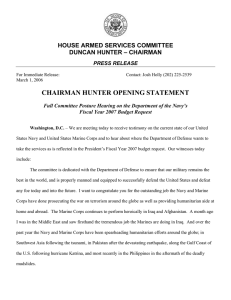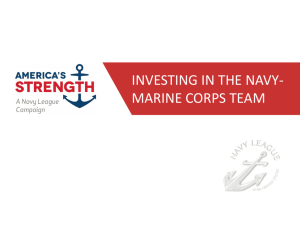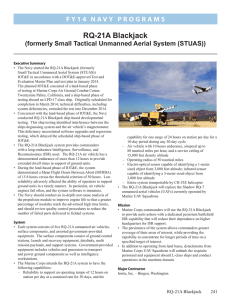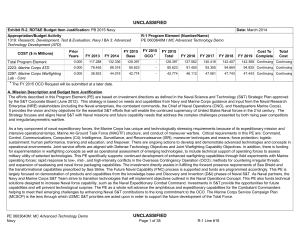Small Tactical Unmanned Aerial System (STUAS) Tier II
advertisement
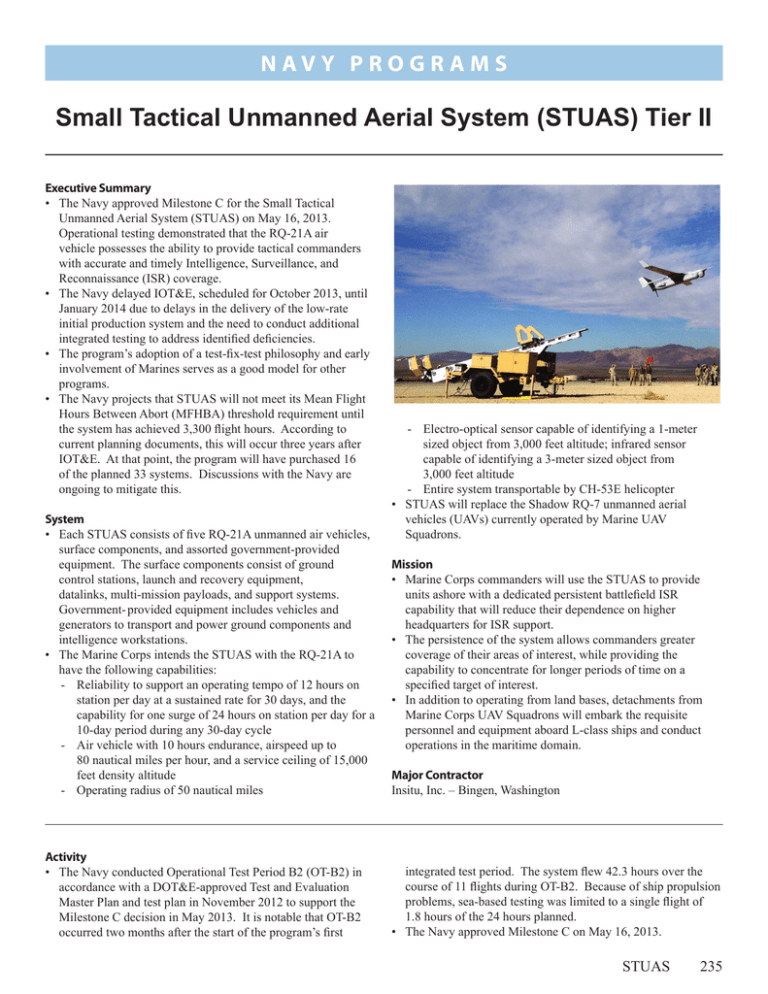
N av y P R O G R A M S Small Tactical Unmanned Aerial System (STUAS) Tier II Executive Summary • The Navy approved Milestone C for the Small Tactical Unmanned Aerial System (STUAS) on May 16, 2013. Operational testing demonstrated that the RQ-21A air vehicle possesses the ability to provide tactical commanders with accurate and timely Intelligence, Surveillance, and Reconnaissance (ISR) coverage. • The Navy delayed IOT&E, scheduled for October 2013, until January 2014 due to delays in the delivery of the low-rate initial production system and the need to conduct additional integrated testing to address identified deficiencies. • The program’s adoption of a test-fix-test philosophy and early involvement of Marines serves as a good model for other programs. • The Navy projects that STUAS will not meet its Mean Flight Hours Between Abort (MFHBA) threshold requirement until the system has achieved 3,300 flight hours. According to current planning documents, this will occur three years after IOT&E. At that point, the program will have purchased 16 of the planned 33 systems. Discussions with the Navy are ongoing to mitigate this. System • Each STUAS consists of five RQ-21A unmanned air vehicles, surface components, and assorted government‑provided equipment. The surface components consist of ground control stations, launch and recovery equipment, datalinks, multi‑mission payloads, and support systems. Government- provided equipment includes vehicles and generators to transport and power ground components and intelligence workstations. • The Marine Corps intends the STUAS with the RQ-21A to have the following capabilities: - Reliability to support an operating tempo of 12 hours on station per day at a sustained rate for 30 days, and the capability for one surge of 24 hours on station per day for a 10-day period during any 30-day cycle - Air vehicle with 10 hours endurance, airspeed up to 80 nautical miles per hour, and a service ceiling of 15,000 feet density altitude - Operating radius of 50 nautical miles Activity • The Navy conducted Operational Test Period B2 (OT-B2) in accordance with a DOT&E-approved Test and Evaluation Master Plan and test plan in November 2012 to support the Milestone C decision in May 2013. It is notable that OT-B2 occurred two months after the start of the program’s first - Electro-optical sensor capable of identifying a 1-meter sized object from 3,000 feet altitude; infrared sensor capable of identifying a 3-meter sized object from 3,000 feet altitude - Entire system transportable by CH-53E helicopter • STUAS will replace the Shadow RQ-7 unmanned aerial vehicles (UAVs) currently operated by Marine UAV Squadrons. Mission • Marine Corps commanders will use the STUAS to provide units ashore with a dedicated persistent battlefield ISR capability that will reduce their dependence on higher headquarters for ISR support. • The persistence of the system allows commanders greater coverage of their areas of interest, while providing the capability to concentrate for longer periods of time on a specified target of interest. • In addition to operating from land bases, detachments from Marine Corps UAV Squadrons will embark the requisite personnel and equipment aboard L-class ships and conduct operations in the maritime domain. Major Contractor Insitu, Inc. – Bingen, Washington integrated test period. The system flew 42.3 hours over the course of 11 flights during OT-B2. Because of ship propulsion problems, sea-based testing was limited to a single flight of 1.8 hours of the 24 hours planned. • The Navy approved Milestone C on May 16, 2013. STUAS 235 N av y P R O G R A M S • The Navy delayed IOT&E, scheduled for October 2013, until January 2014 due to delays in the delivery of the low-rate initial production system and the need to conduct additional integrated testing to address identified deficiencies. - IOT&E is scheduled to occur as part of a Marine Corps Integrated Training Exercise at the Marine Corps Air Ground Combat Center at Twenty-nine Palms, California. - During IOT&E, STUAS will support Marine Corps ground units preparing to deploy. • The system experienced air vehicle mishaps on September 19, 2012, and January 14, 2013. In the first mishap, the air vehicle experienced a structural failure during launch. The second mishap also occurred during launch. In this case, a loose circuit board pin on the Electronic Control Unit processor contacted the unit’s housing, producing a short circuit that resulted in engine shutdown and a hard landing. Assessment • OT-B2 demonstrated that the RQ-21A possesses the ability to provide tactical commanders with accurate and timely ISR coverage. The program’s adoption of a test-fix-test philosophy and early involvement of Marine operators and maintainers serves as a good model for other programs. • The Navy projects that STUAS will not meet its MFHBA threshold requirement until the system has achieved 3,300 flight hours. According to current planning documents, this will occur three years after IOT&E. At that point, the 236 STUAS program will have purchased 16 of the planned 33 systems. Discussions with the Navy are ongoing to mitigate this. • The Marine Corps based the MFHBA threshold criteria of 50 hours on the performance of other unmanned systems. It is not readily apparent that the 50-hour threshold does or does not fully support the desired operating tempo and operating and support costs budgeted for system operations. • While the occurrence of mishaps is not uncommon in unmanned systems early in their development, it is noteworthy that both mishaps might be attributable to the manufacturing process. The Navy has taken steps to address quality control during production. Recommendations • Status of Previous Recommendations. This is the first annual report for the program. • FY13 Recommendations. The Navy and Marine Corps should: 1. Conduct a comprehensive review of STUAS reliability versus requirements. The MFHBA threshold criterion of 50 hours should be reviewed to assess how this value supports operational effectiveness and suitability. 2. Increase annual operating hours in order to reach the projected 3,300 flight hours sooner than 2017. This increase in operating tempo would allow the Navy to identify and correct failure modes before committing to buy a significant number of systems.
